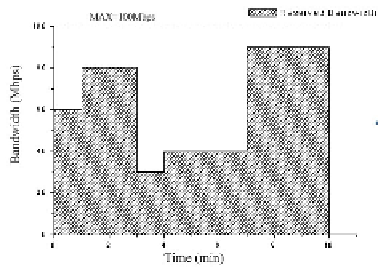Information Technology Reference
In-Depth Information
processing of data structure, 8 percent for the selection of appropriate resources, and
the remaining 32 percent for the management of resource extraction in resource reser-
vation [2]. If an application request is for the whole potential advance reservation
services, it will cost more time. For example, during the interval of scanning and de-
tecting resources, the processing time of data structure is up to 90% of the total time.
The optimization of data structure can greatly improve the speed of processing in
the resource advance reservation. The key issues to be resolved for data structure of
advance reservation are to reduce the data redundancy and use of storage space, and
to improve the processing and search speed. Two new non-slotted data structures—a
resource clue tree and a resource binary tree—are proposed in this paper to solve the
previous problem. Compared with the traditional timeslot array, the resource clue tree
shows better description, processing and store performance.
2
Reservation Request and Reservation Procedure
Resource reservation is divided into immediate reservation and advance reservation.
The first one is a quick way to respond to reservation requests. The applicant imme-
diately starts using the resources after the reservation request is accepted. The advance
reservation is a way of using the reserved resources a period of time after the reservation
is made. Advance reservations include two stages: negotiation and use phase.
The resource reservation request (
req
) is represented by a triple
bw
,
ts
,
te
in this
paper. The parameters
ts
and
te
represent the start time and the end time respectively.
The parameter
bw
represents the amount of requested resources (bandwidth). The
method of generating reservation requests will be described in section 6.1.
Resource reservations are usually required to handle a large number of requests in
a short time. One important task is the admission control-as long as there is a new
request, the service provider must check whether there are sufficient resources availa-
ble for it. So it needs some data structures to store the summary information of all
reservation requests. Figure 1 indicates the situation of a resource reservation in some
time, which is the virtual representation of information stored in a data structure. The
amounts of idle resources can be clearly seen at any time and it is not difficult to infer
the results of the admission control for a new reservation request.
Fig. 1.
Schematic diagram of a resource reservation

